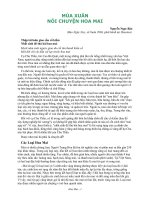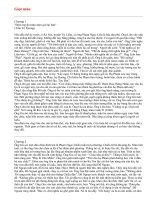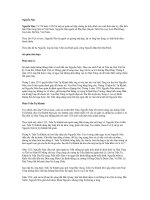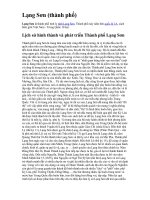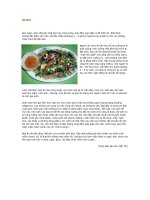Tài liệu ORCHID BIOTECHNOLOGY ppt
Bạn đang xem bản rút gọn của tài liệu. Xem và tải ngay bản đầy đủ của tài liệu tại đây (3.38 MB, 277 trang )
ORCHID
BIOTECHNOLOGY
This page intentionally left blankThis page intentionally left blank
BIOTECHNOLOGY
ORCHID
edited by
Wen-Huei Chen
National Inoversity of Kaohsiung, Taiwan
Hong-Hwa Chen
National Cheng Kung University, Taiwan
World Scientific
N E W J E R S E Y • L O N D O N • S I N G A P O R E • B E I J I N G • S H A N G H A I • H O N G K O N G • TA I P E I • C H E N N A I
Library of Congress Cataloging-in-Publication Data
Orchid biotechnology / editors, Hong-Hwa Chen, W.H. Chen.
p. cm.
Includes bibliographical references and index.
ISBN-13: 978-981-270-619-5 (hardcover : alk. paper)
ISBN-10: 981-270-619-4 (hardcover : alk. paper)
1. Orchids Biotechnology. I. Chen, Hong-Hwa. II. Chen, W. H. (Wen Huei)
QK495.O64O55 2007
635.9'344 dc22
2007016772
British Library Cataloguing-in-Publication Data
A catalogue record for this book is available from the British Library.
For photocopying of material in this volume, please pay a copying fee through the Copyright
Clearance Center, Inc., 222 Rosewood Drive, Danvers, MA 01923, USA. In this case permission to
photocopy is not required from the publisher.
Typeset by Stallion Press
Email:
All rights reserved. This book, or parts thereof, may not be reproduced in any form or by any means,
electronic or mechanical, including photocopying, recording or any information storage and retrieval
system now known or to be invented, without written permission from the Publisher.
Copyright © 2007 by World Scientific Publishing Co. Pte. Ltd.
Published by
World Scientific Publishing Co. Pte. Ltd.
5 Toh Tuck Link, Singapore 596224
USA office: 27 Warren Street, Suite 401-402, Hackensack, NJ 07601
UK office: 57 Shelton Street, Covent Garden, London WC2H 9HE
Printed in Singapore.
Orchid Biotechnology.pmd 8/29/2007, 3:41 PM1
Foreword
The Phalaenopsis is the national flower of Taiwan, first found and col-
lected by the Japanese on Lanyu (Orchid Island) in 1897. After winning
back-to-back championships in the International Orchid Exhibition in
California in 1952 and 1953, Taiwan’s native Phalaenopsis has gained
worldwide admiration and the pride of the Taiwanese people.
With an optimal climate for growing the Phalaenopsis, Taiwan is
well situated for commercialization of the flower, being in the northern-
most area of Phalaenopsis’ natural germplasm. Today, the Phalaenopsis
industry in Taiwan is well developed and has advanced to green house
breeding and systematic production. Moreover, Taiwanese product
varieties now account for more than 50% of the global Phalaenopsis
market share. It is no surprise that the Phalaenopsis industry is
viewed as an example of the most advanced knowledge-based agriculture
in Taiwan.
The future of the Phalaenopsis is exceptionally bright. On August
24, 2004, the New York Times reported that there is a $2 billion global
market for orchids, with Phalaenopsis holding the leading share within
that market. Phalaenopsis is also recognized as one of the most exciting
and elegant indoor flowers by the American Orchid Society (AOS). And
recently, Mr. Ed Matsui, owner of Matsui Nursery, the largest
Phalaenopsis producer in the US, has estimated there will be a five-fold
increase in the Phalaenopsis market within the next ten years.
Furthermore, according to the December 2004 issue of Flora-
Culture International, the most influential floral magazine, the
Phalaenopsis, a newly developing flower with 20% growth each year for
the past five years, is the top seller among all pot flowers in The
Netherlands and Japan. Moreover, with the advent of mass retail as a
new distribution channel, demand has increased for mini-type, low-
priced product, and color variants, boosting flower sales in recent years.
All these factors have led to the Phalaenopsis being selected as one
of the top four most important export products for Taiwan by the
Agriculture Product Competition Module (APCM), a group developed
v
FA
b494_FM.qxd 8/29/2007 1:48 PM Page v
by A-Turn Biotech Company, an advisor to the government for agricul-
ture, to analyze and evaluate potential floral products for export.
However, the value created by the Phalaenopsis is greater than that
of just the plant itself; strategic alliances with other industries will pro-
vide the opportunity for extracting further value and greater margin
from the flower. Phalaenopsis is recognized as a symbol of elegance
amongst flowers. Properly managed, this rare property enables the
attraction and development of many complementary products and
industries such as gifts, arts, and home decoration.
As Taiwan moves into the future, the establishment of acclimation
and overseas sales points is one of the important steps in broadening
the market of Phalaenopsis globally. Taiwan has a complete range of
technologies from seedling acclimation to product vernalization.
Through international strategic alliances enabling joint ventures and
technology transfer, Taiwan will create higher profits through widening
markets internationally for all parties involved.
Currently, due to shipping costs and importation regulations, cer-
tain finished Phalaenopsis products are not able to reach the US mar-
kets. Thus, establishing a local acclimation facility for consumers is now
the most cost effective way to market and distribute Phalaenopsis.
Fortunately, the US government has recently begun accepting the
importation of Phalaenopsis with moss as a supporting medium, which
will provide a new international trading opportunity for Taiwan.
There are many factors that contribute to Taiwan’s unique capabil-
ity to take the greatest advantage of the Phalaenopsis phenomenon. As
mentioned above, the subtropical climate makes Taiwan a near perfect
environment for the production of Phalaenopsis. In addition, Taiwan is
rich in orchid species, holding a worldwide leading position in new
product development fueled by hundreds of professional and amateur
breeders who have won gold medals in world competitions. Taiwan has
maintained and will continue to maintain its competitive edge on
research and development in the Phalaenopsis business.
From a technical perspective, Taiwan’s Phalaenopsis industry has
the strength to compete with any of the major floral countries. It is
strongly supported by The National Science and Technology Program
for Agricultural Biotechnology (NSTP.AB), a joint program of the National
Science Council, Council of Agriculture and Academia Sinica. The
NSTP.AB supports universities and research institutions in advancing
the technology in genetic transforming, tissue culture, and production.
vi
✦
Foreword
FA
b494_FM.qxd 8/29/2007 1:48 PM Page vi
Most of the chapters in this book have come about as a result of this
National Project and I am honored to have served as the team leader
since the initiation of the project in 1998.
For many years, significant advances in the biotechnological
research of Phalaenopsis have been made in the areas of thermo-toler-
ance, pathogen resistance, flowering control, flower color and virus
diagnosis. This strength of research ability and experience should
attract international cooperation on technological applications.
Taiwan’s Phalaenopsis production system has evolved to a com-
mercialized scale by through involvement of many breeders and com-
panies. In addition, it has developed into a complete high tech system,
i.e. from product selection, healthy seedling propagation, quarantine
systems, and production automation, which form a well-set package in
agriculture developments. As such, it is well situated for forming strate-
gic alliances worldwide as a turn key project.
In order to vertically integrate the orchid industry, the Council for
Economic Planning and Development, has established and funded the
Taiwan Orchid Plantation (TOP) in Tainan County in 2003. TOP was
designed and developed by myself together with the management team
of A-Turn Biotech. We believe that TOP will be the platform to
strengthen the orchid industry in R&D, mass production, exhibition,
trading and so forth, which will make Taiwan the largest orchid sup-
plier in the world. In addition, the “TOP” name will provide a strong
differentiating brand for Taiwan’s Phalaenopsis.
Since there are many highly skilled breeders and technology develop-
ers on the island, TOP will also be acting as a platform for trading orchid
varieties and technologies internationally. Taiwan has the capability to
custom-make specific products for every specific market in the shortest
possible period because of its rich breeding materials and skillful breeders.
This will enhance its position as a global leader of Phalaenopsis suppliers.
Technological development is the foundation of the industry; it
takes tremendous time and investment to build up, but is absolutely
essential. I am glad to see this book published and believe that the book
will become the most useful and valuable technological resource for all
orchid lovers worldwide.
Dr. Irwin Y.E. Chu
Founder
A-Turn Biotech Co.
Foreword
✦
vii
FA
b494_FM.qxd 8/29/2007 1:48 PM Page vii
FA
b494_FM.qxd 8/29/2007 1:48 PM Page viii
This page intentionally left blankThis page intentionally left blank
Preface
The appreciation of orchid beauty has a long history in both western
and eastern cultures. Over many years of development, the orchid has
evolved such that it embraces not just the hobbyists’ market but a
highly commercial market, thanks to advances in techniques such as
breeding, micropropagation, industrial cultivation, etc. Today, orchid
cut-flowers of Cymbidium, Dendrobium and Oncidium, and potted
plants of Phalaenopsis are marketed globally. It is envisaged that grow-
ing tropical orchids for cut-flower production and potted plants will
benefit from the recent advances in the crop science technology.
However, for the orchid industry, producing an improved orchid
through biotechnology is only the beginning.
Taiwan has been the main driving force of the world’s Phalaenopsis
breeding and plant production. The orchid research program was firstly
supported 10 years ago by the Taiwan Sugar Corporation for the first
three years, and currently has been one of the National Science-Tech
Program for Agriculture Biotechnology (NSTP.AB) for more than six
years. The budgets of the NSTP.AB are founded by National Science
Council, Council of Agriculture and Academic Sinica, Taiwan. The con-
tributors to the book include researchers from the Institute of Plant
and Microbial Biology, Academia Sinica, National Taiwan University,
National Tsing Hua University, National Cheng Kung University,
National University of Kaohsiung, and National Pingtung University of
Science & Technology. We collaborate with the growers of Taiwan
Orchid Plantation, a government sponsored entity, in terms of research
and training, in order to bring the Taiwan orchid industry to a new level
of sophistication and profitability.
This book is the first volume devoted exclusively to orchid biotech-
nology. It is extremely informative as it addresses many aspects of
orchid biotechnology, including modern breeding (Chapters 1 and 2),
in vitro morphogenesis (Chapter 3), somaclonal variation (Chapter 4),
application of orchid mycorrhized fungi (Chapter 5), analysis of orchid
genomes (Chapters 6–8) and functional genomics (Chapters 9–12), and
ix
FA
b494_FM.qxd 8/29/2007 1:48 PM Page ix
genetic transformation (Chapter 13). It will be a valuable guide for
readers such as research workers, graduate students, people interested
in orchid biology and floriculturists. Its publication will be a milestone
sets the foundation for the next level of orchid research.
Wen-Huei Chen and Hong-Hwa Chen
The Editors
x
✦
Preface
FA
b494_FM.qxd 8/29/2007 1:48 PM Page x
Contents
Foreword v
Preface ix
List of Contributors xiii
Chapter 1 Breeding and Development of New Varieties 1
in Phalaenopsis
Ching-Yan Tang and Wen-Huei Chen
Chapter 2 Embryo Development of Orchids 23
Yung-I Lee, Edward C Yeung and
Mei-Chu Chung
Chapter 3 In vitro Morphogenesis and Micro-Propagation 45
of Orchids
Wei-Chin Chang
Chapter 4 Somaclonal Variation in Orchids 65
Fure-Chyi Chen and Wen-Huei Chen
Chapter 5 The Screening of Orchid Mycorrhizal Fungi 77
(OMF) and their Applications
Doris C. N. Chang
Chapter 6 Analysis of the Orchid Genome Size Using 99
Flow Cytometry
Tsai-Yun Lin and Hsiao-Ching Lee
xi
FA
b494_FM.qxd 8/29/2007 1:48 PM Page xi
Chapter 7 The Cytogenetics of Phalaenopsis Orchids 115
Yen-Yu Kao, Chih-Chung Lin, Chien-Hao Huang
and Yi-Hsueh Li
Chapter 8 Analysis of the Chloroplast Genome of 129
Phalaenopsis aphrodite
Ching-Chun Chang, Hsien-Chia Lin and
Wun-Hong Zeng
Chapter 9 Analysis of Expression of Phalaenopsis 145
Floral ESTs
Wen-Chieh Tsai, Yu-Yun Hsiao, Zhao-Jun Pan
and Hong-Hwa Chen
Chapter 10 Orchid MADS-Box Genes Controlling Floral 163
Morphogenesis
Wen-Chieh Tsai, Chin-Wei Lin,
Chang-Sheng Kuoh and Hong-Hwa Chen
Chapter 11 Pseudobulb-Specific Gene Expression of Oncidium 185
Orchid at the Stage of Inflorescence Initiation
Jun Tan, Heng-Long Wang and Kai-Wun Yeh
Chapter 12 Application of Virus-induced Gene Silencing 211
Technology in Gene Functional Validation
of Orchids
Hsiang-Chia Lu, Hong-Hwa Chen and
Hsin-Hung Yeh
Chapter 13 Genetic Transformation as a Tool for 225
Improvement of Orchids
Sanjaya and Ming-Tsair Chan
Index 255
xii
✦
Contents
FA
b494_FM.qxd 8/29/2007 1:48 PM Page xii
xiii
FA
List of Contributors
Ming-Tsair Chan
Agricultural Biotechnology Research Center
Academia Sinica
Taipei
Taiwan
Ching-Chun Chang
Institute of Biotechnology
National Cheng Kung University
Tainan
Taiwan
Doris C. N. Chang
Department of Horticulture
National Taiwan University
Taipei
Taiwan
Wei-Chin Chang
Institute of Plant and Microbial Biology
Academia Sinica
Taipei
Taiwan
Fure-Chyi Chen
Department of Plant Industry and Graduate Institute
of Biotechnology
National Pingtung University of Science & Technology
Pingtung
Taiwan
b494_FM.qxd 8/29/2007 1:48 PM Page xiii
Hong-Hwa Chen
Department of Life Sciences
National Cheng Kung University
Tainan
Taiwan
Wen-Huei Chen
Department of Life Sciences
National University of Kaohsiung
Kaohsiung
Taiwan
Mei-Chu Chung
Institute of Plant and Microbial Biology
Academia Sinica
115, Taipei
Taiwan, ROC
Yu-Yun Hsiao
Department of Life Sciences
National Cheng Kung University
Tainan
Taiwan
Chien-Hao Huang
Department of Botany
National Taiwan University
Taipei
Taiwan
Yen-Yu Kao
Department of Botany
National Taiwan University
Taipei
Taiwan
Institute of Molecular and Cellular Biology
National Taiwan University
Taipei
Taiwan
xiv
✦
List of Contributors
FA
b494_FM.qxd 8/29/2007 1:48 PM Page xiv
Chang-Sheng Kuoh
Department of Life Sciences
National Cheng Kung University
Tainan
Taiwan
Hsiao-Ching Lee
Institute of Bioinformatics and Structural Biology and
Department of Life Science
National Tsing Hua University
Hsinchu
Taiwan
Yung-I Lee
Institute of Plant and Microbial Biology
Academia Sinica
115, Taipei
Taiwan, ROC
Botany Department
National Museum of Natural Science
Taichung
Taiwan
Yi-Hsueh Li
Department of Botany
National Taiwan University
Taipei
Taiwan
Chih-Chung Lin
Department of Botany
National Taiwan University
Taipei
Taiwan
Chin-Wei Lin
Department of Life Sciences
National Cheng Kung University
Tainan
Taiwan
List of Contributors
✦
xv
FA
b494_FM.qxd 8/29/2007 1:48 PM Page xv
Hsien-Chia Lin
Institute of Biotechnology
National Cheng Kung University
Tainan
Taiwan
Tsai-Yun Lin
Institute of Bioinformatics and Structural Biology
and Department of Life Science
National Tsing Hua University
Hsinchu
Taiwan
Hsiang-Chia Lu
Department of Plant Pathology and Microbiology
National Taiwan University
Taipei
Taiwan
Zhao-Jun Pan
Department of Life Sciences
National Cheng Kung University
Tainan
Taiwan
Sanjaya
Agricultural Biotechnology Research Center
Academia Sinica
Taipei
Taiwan
Jun Tan
College of Bioinformation
Chongqing University of Post and Telecom
Chongqing
China
xvi
✦
List of Contributors
FA
b494_FM.qxd 8/29/2007 1:48 PM Page xvi
Ching-Yan Tang
Department of Life Sciences
National University of Kaohsiung
Kaohsiung
Taiwan
Wen-Chieh Tsai
Department of Biological Science and Technology
Chung Hwa University of Medical Technology
Tainan County
Taiwan
Heng-Long Wang
Department of Life Science
National Kaohsiung University
Kaohsiung
Taiwan
Edward C. Yeung
Department of Biological Sciences
University of Calgary
Calgary
Alberta T2N 1N4
Canada
Hsin-Hung Yeh
Department of Plant Pathology and Microbiology
National Taiwan University
Taipei
Taiwan
Kai-Wun Yeh
Institute of Plant Biology
College of Life Science
National Taiwan University
Taipei
Taiwan
List of Contributors
✦
xvii
FA
b494_FM.qxd 8/29/2007 1:48 PM Page xvii
Wun-Hong Zeng
Institute of Biotechnology
National Cheng Kung University
Tainan
Taiwan
xviii
✦
List of Contributors
FA
b494_FM.qxd 8/29/2007 1:48 PM Page xviii
Chapter 1
Breeding and Development of
New Varieties in Phalaenopsis
Ching-Yan Tang
†
and Wen-Huei Chen
*
,
†
One of the most important strategies to keep Taiwan as the leading pro-
ducer of Phalaenopsis in the world, is breeding and development of new
varieties. Pedigree analysis of the 12 most popular white hybrids of
Phalaenopsis indicated that the tetraploids of Phal. amabilis and the
hybrid, Phal. Doris were used frequently as parents of these hybrids.
Besides the standard big flower Phalaenopsis, development of novelty
varieties, such as the Harlequins and the multi-floral types constitute
the new trends in the Phalaenopsis breeding programs and markets in
the last decade. The somaclonal mutants of Phal. Golden Peoker and the
wild species, Phal. equestris played an important role in the development
of these novelty varieties. Breeding for new varieties of Phalaenopsis is
lengthy and time consuming. New techniques are needed to increase the
breeding efficiency of crops having long life cycles. The recent develop-
ment of molecular markers, such as restricted fragment length poly-
morphism (RFLP), random amplified polymorphic DNA (RAPD) and
DNA amplification fingerprinting (DAF) and their applications in
Phalaenopsis breeding are discussed and evaluated in this chapter.
1.1 Introduction
The 1980s was the decade that has divided the orchid business of
Taiwan into two distinct phases. Before 1980, the cultivation of orchid
1
FA
*
Corresponding author.
†
Department of Life Sciences, National University of Kaohsiung, Kaohsiung, Taiwan.
b494_Ch-01.qxd 8/29/2007 1:26 PM Page 1
was considered a hobby. Most hobbyists were raising orchids in small
scale with simple green-house facilities. With the rapid growth of
economy, Phalaenopsis orchids became one of the most important
commodity in the domestic as well as the international markets.
Since 1988, Taiwan Sugar Corporation has started a comprehensive
program to modernize Phalaenopsis production through intensive
research effort, while more modern and well-equipped greenhouses
1
were built to meet the demands of an expanding market which could
not be met through the activities of orchid hobbyists. Moreover,
Phalaenopsis breeding became more professional and was usually well
designed as compared with the trial and error approach of the tradi-
tional breeding programs.
Another change during this period was the product type in the
export markets. Instead of cut flowers, the medium- and large-sized
seedlings of selected hybrids became the major items for export.
Consequently, Phalaenopsis growers in Taiwan had to equip them-
selves with modern greenhouses as well as facilities for mass produc-
tion of hybrid seedlings which are normally derived from crosses
of two high quality parental varieties. Seeds from the mature cap-
sules are sown by in vitro method. Young seedlings developed in the
test tube are transplanted into pots which are divided into four
groups: small-, medium-, and large-sized seedlings and flowering
plants, according to market demands.
2
Progeny test is used to evalu-
ate and select the potential hybrids at different stages of develop-
ment. To save time, parental plants used for hybridization to produce
hybrids are propagated by the mericlone method, while evaluation of
the new hybrids is in progress. Therefore, at the final stage of selec-
tion of the hybrids, there will be enough parental stocks available for
making crosses to produce a large amount of hybrid seedlings for the
market.
3
The Phalaenopsis varieties used for breeding are usually divided
into two groups — the standard big flower group and the novelty group.
The standard big flower group includes the white, pink as well as the
varieties with stripes, being derivatives of the white Phal. amabilis and
the pink Phal. schilleriana. The varieties of the novelty group are usu-
ally small flowers with special coloration; some have special fragrances,
i.e. if Phal. violacea is involved in the pedigree. Other parental varieties
in this group are Phal. amboinensis, Phal. venosa, etc. In recent years,
2
✦
C Y. Tang and W H. Chen
FA
b494_Ch-01.qxd 8/29/2007 1:26 PM Page 2
the pot varieties which have small but plentiful flowers have become a
new market trend. Phal. equestris and Phal. stuartiana are the common
parental varieties of this group.
In general, the breeding programs are designed to improve the size
and color of the flowers as well as other characteristics such as,
longevity, stalk length, leaf shape, ease of cultivation, disease resistance
and the number of viable seeds through the selection of parents for
hybridization and so on. Through tremendous efforts in breeding, vari-
ous types of Phalaenopsis varieties with attractive color and graceful
appearance (Fig. 1.1) have been developed and the success of the devel-
opment has made Taiwan one of the most important producers of
Phalaenopsis in the world.
The growing cycles of Phalaenopsis orchids are long, a cycle being
2–3 years. Using the traditional hybridization to transmit useful traits
into the commercial varieties is a long process which takes years to
achieve. In addition, some species of orchids are cross-incompatible,
thereby limiting the work of variety improvement. Hence, new
approaches and techniques are needed in order to produce superior
Phalaenopsis varieties for the fast growing and highly competitive mar-
kets. This chapter discusses the recent developments in the breeding
work of Phalaenopsis.
Breeding and Development of New Varieties in Phalaenopsis
✦
3
FA
Fig. 1.1. Phalaenopsis varieties showing various attractive colors and grace-
ful appearance.
b494_Ch-01.qxd 8/29/2007 1:26 PM Page 3
1.2 Development of Phalaenopsis Varieties
by Hybridization
1.2.1 White Phalaenopsis varieties
The standard big white flower is the most important group of
Phalaenopsis in the market (Fig. 1.2). Besides the large size, the breed-
ing objectives of the white Phalaenopsis include long flower stalk, well-
shaped flowers with long life span, etc. Taiwan is located at the northern
border of the natural growth habitat of Phalaenopsis. A white flowered
species, Phal. amabilis var. formosa was found native in Heng-Chung
Peninsula, Taitung County and the Orchid Island off the coast of south-
ern Taiwan.
4
This native species had won several awards in different
international orchid conferences as early as in the 1950s for the beauty
of their multi-flowers. By using the technique of polyploidization, supe-
rior tetraploid varieties with short flower stalk, round-shaped petals
and good quality flowers were developed. These varieties were well
accepted by the Japanese market.
The modern superior large white hybrids were developed through
the hybridization of breeding stocks from different sources, including
those from the local Phalaenopsis farms and many from foreign coun-
tries, such as Japan, the Netherlands and the United States. Based on
these materials, large, well-shaped white-flowered Phalaenopsis
4
✦
C Y. Tang and W H. Chen
FA
Fig. 1.2. The appearance the standard big white variety “Phal. Taisuco Brinasu.”
b494_Ch-01.qxd 8/29/2007 1:26 PM Page 4
hybrids with uniform morphology were developed. Through analysis of
the pedigree of the 12 most popular white Taisuco Phalaenopsis hybrids
in 1997/98, it was found that all of them were the offspring of Phal.
amabilis, Phal. rimestadiana, Phal. aphrodite, Phal. schilleriana, Phal.
stuartiana and Phal. sanderiana with the exception of the Phal. Taisuco
white which was not related to Phal. stuartiana and Phal. sanderiana
(Table 1.1). Among these wild species, Phal. amabilis, Phal. rimestadiana
and Phal. aphrodite were the most important ancestors for the modern
white commercial hybrids.
5
The proportion of the genetic constitution
contributed by Phal. amabilis, Phal. rimestadiana and Phal. aphrodite
were 40.34%, 38.56%, and 16.41%, respectively. Based on this information,
one can note that these hybrids were closely related in their genetic
make-up. This narrow genetic background in Phalaenopsis white hybrids
was difficult to avoid due to the demand for high uniformity of the
hybrid seedlings by the market. That means genetic homogeneity of the
parental stocks was required in order to produce uniform hybrid seedlings.
However, one has to be aware that genetic depression may occur during
the process of improvement.
From the same analysis, it was found that these 12 Taisuco hybrids
were originated from 17 ancestral hybrids (Table 1.2). However, the
Breeding and Development of New Varieties in Phalaenopsis
✦
5
FA
Table 1.1. Genetic Contribution of the Wild Species for the 12 Most
Popular Commercial Hybrids
a
of the White Taisuco Phalaenopsis
Wild Species Used Percentage of Mean of
in the Pedigree Genetic Contribution Percentage C.V.
b
Phal. amabilis 39.11–42.19 40.34 2.8
Phal. rimestadiana 37.64–39.22 38.56 1.2
Phal. aphrodite 15.36–17.74 16.41 4.3
Phal. schilleriana 2.64–4.49 3.48 19.8
Phal. stuartiana 0–1.17 0.51 70.6
Phal. sanderiana
c
0–0.78 0.47 51.1
a
The name of the 12 hybrids are: Phal. Taisuco Kochdian, Phal. Taisuco Kaaladian,
Phal. Taisuco Windian, Phal. Taisuco Bright, Phal. Taisuco Bridian, Phal. Taisuco
Adian, Phal. Taisuco White, Phal. Taisuco Brinasu, Phal. Taisuco Silver, Phal. Taisuco
Crane, Phal. Taisuco Swan, Phal. Taisuco Nasubula.
b
C.V. = coefficient of variation.
c
The commercial hybrid, Phal. Taisuco White, does not have the genetic contribution of
Phal. stuartiana and Phal. sanderiana.
b494_Ch-01.qxd 8/29/2007 1:26 PM Page 5
average genetic contribution for Phal. Doris to the current large white
Phalaenopsis hybrids was about 50.47%, which was equally important
to the direct parental hybrids. Through the genetic flow from the ances-
tors to the modern white Taisuco hybrids, it is observed that the supe-
rior clones of the large white Taisuco Phalaenopsis were developed
firstly through the improvement of the genetic characters for Phal.
Doris by chromosome doubling, resulting in a tetraploid with a larger
genomic capacity to accumulate more additive alleles. Then it was
6
✦
C Y. Tang and W H. Chen
FA
Table 1.2. Genetic Contribution of the Important Parental Hybrids
in the Pedigree of the 12 Most Popular Commercial Hybrids
a
of the
White Taisuco Phalaenopsis
Name of Genetic No. of
Parental Hybrid Contribution (%) Commercial Hybrids
Group A
Phal. Elisabethae 40.23 12
Phal. Gilles Gratiot 30.69 12
Phal. Katherine Siegwart 31.56 12
Group B
Phal. Doris 50.47 12
Phal. Doreen 17.36 9
Phal. La Canada 12.18 9
Phal. Winged Victory 19.37 12
Group C
Phal. Grace Palm 23.57 12
Phal. Thomas Tucker 12.26 9
Group D
Phal. Elinor Shaffer 18.75 10
Phal. Long Life 14.84 8
Phal. Opaline 14.84 8
Phal. Vallehigh 22.27 8
Group E
Phal. Kochs Schneestern 27.78 9
Phal. Meridian 27.78 9
Phal. Mount Kaala 26.70 11
Phal. Schone Von Unna 14.84 8
a
The names of the 12 hybrids are the same as in Table 1.1.
b494_Ch-01.qxd 8/29/2007 1:26 PM Page 6


